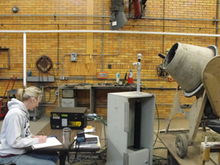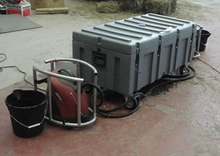Quick facts
Steaming shouldn’t replace the main goal of feeding hay with low mold and dust content. In the absence of such hay, steaming is a good practice for reducing mold and dust content in moderately moldy hay. You can use steaming to increase forage intake when feeding low mold hay.
Horses are highly sensitive to mold and dust particles from hay and bedding. Breathing in mold or dust can result in respiratory problems. Soaking hay for no more than 60 minutes before feeding can help horses with respiratory problems. Unfortunately, soaking can cause leaching of essential nutrients.
Hay steaming is widely accepted in Europe and is gaining popularity in the United States. We looked at the impact steaming has on forage nutritive value and intake.
Testing steamed hay
We tested steaming on two alfalfa-orchardgrass mixed hays that were low or moderately moldy. We used six adult horses to evaluate preference of steamed and unsteamed hay. We assigned three horses to each hay type (low or moderately moldy) for five days. On day six, we switched the horses to the other hay type.
Each day, we sampled one bale of each hay type for forage quality before and after steaming. We steamed the hay for 90 minutes in a commercial hay steamer. We weighed and offered two flakes of steamed or unsteamed low or moderately moldy hay simultaneously to each horse in individual hay nets.
We allowed the horses 2 hours of access to the hay. We collected the remaining hay and calculated the dry matter intake (DMI). We evaluated the effect of steaming on dust content (TSP) using an additional six bales of both hay types.
Results of hay steaming for 90 minutes
Steaming increased the moisture in hay. As a result, the dry matter declined to 77 and 81 percent for low and moderately moldy hay, respectively. Make sure to feed the hay shortly after steaming it. Increased moisture in hay can make it more prone to mold and loss of nutritive value.
In both hays, steaming reduced phosphorus (P) content by 16 and 17 percent. In this case, the decline in P likely didn’t cause a deficiency in the horses’ diets. A P deficiency may occur if your hay has little P prior to steaming it.
Calcium (Ca) isn’t water soluble and thus steaming could further magnify Ca to P ratio imbalances. This mostly pertains to pure alfalfa hay.
Steaming reduced water soluble (WSC) and ethanol soluble carbohydrates (ESC) by 13 and 27 percent, respectively in moderately moldy hay. Steaming didn’t affect WSC or ESC in low mold hay.
Mold often results from a higher moisture levels at the time of baling. Bales with a higher moisture content tend to heat up after baling. It’s possible that in the moderately moldy hay, the heat made WSC and ESC more prone to leaching during steaming. We believe this process didn’t occur in the low mold hay. Thus, this likely contributed to a difference in post-steaming WSC and ESC content between the hay types.
Total suspended particulate (TSP; a measurement of "dust particles") of moderately moldy hay was reduced by 91 percent. Steaming didn’t affect TSP in low mold hay. Unfortunately, there are no established guidelines for the maximum amount of TSP that’s acceptable in horse feed.
Steaming reduced mold content in both hays by about 90 percent. Many researchers agree that horse feed shouldn’t contain no more than 500,000 colony forming units per gram (cfu/g) of mold.
Other research demonstrates that steaming reduces mold content in hay. It also shows that horses with Recurrent Airway Obstruction expressed more disease signs while eating unsteamed hay compared to steamed hay. This suggests that horses with respiratory disease may benefit from steamed hay.
Steaming increased DMI of low mold hay. Horses ate 1.4 pounds of unsteamed and 4.4 pounds of steamed low mold hay. Steaming didn’t affect the DMI of moderately moldy hay.
Steaming increased the two-hour DMI of hay with lesser mold contents. Steaming likely softens the hay’s texture and makes it more palatable.
Mold generally decreases the intake of feed by livestock. While steaming decreased the viable mold, it didn’t remove the mold from the forage. Thus if mold is unpalatable to livestock, its presence likely still affects forage intake rates.
It’s theorized that the mold content of the moderately moldy hay was enough to produce an off-taste. This likely caused the horses to eat the same amount of hay before and after steaming.
Steaming versus soaking hay
You can use steaming or soaking to reduce how much dust and mold your horse breathes in while eating affected hay.
Soaking hay in water for less than 60 minutes generally costs less than buying a steamer and steaming hay for 90 minutes. The hay steamer purchased for this trial cost $1,600 plus added shipping and handling (ordered June 2011).
Hay soaking may be more labor intensive than steaming. Both methods have challenges, especially during the winter months in northern climates (i.e. wet hay can freeze).
You need to carefully dispose of the remaining water after soaking or steaming hay. This water contains high levels of nutrients due to leaching.
Steaming hay kills live mold and increases DMI of low mold hay, compared to soaking. We don’t know if there’s a benefit to feeding dead versus alive but wet moldy hay to horses. Regardless, neither soaking or steaming should replace the main goal of feeding hay with low mold and dust content.
Table 1. The effect of steaming on forage nutritive values (on a DM basis, except DM), mold counts, total suspended particulate (TSP) and dry matter intake (DMI) in moderately and low mold alfalfa-orchardgrass mixed hay.
| Moderately moldy - Unsteamed | Moderately moldy - Steamed | Moderately moldy - % Change | Low mold - Steamed | Low mold - Unsteamed | Low mold - % Change | |
|---|---|---|---|---|---|---|
| DM, % | 91 | 81 | -11 | 92 | 77 | -15 |
| WSC, % | 9.4 | 8.3 | -12 | 9.6 | 9 | NS* |
| ESC, % | 6 | 4.2 | -31 | 6.1 | 5 | NS* |
| P, % | 0.34 | 0.29 | -15 | 0.32 | 0.27 | -16 |
| Mold, cfu/g | 268,102 | 24,729 | -91 | 10,020 | 85 | -99 |
| TSP, ?g/m3 kg DM-1 | 758 | 345 | -91 | 406 | 257 | NS* |
| DMI, Lbs./2 hours | 2.9 | 2.7 | NS* | 4.4 | 1.4 | 216 |
*NS = not statistically different
Earing, J.E., M.R. Hathaway, C.C. Sheaffer, B.P. Hetchler, L.D. Jacobson, J.C. Paulson, and K.L. Martinson. 2013. The effect of hay steaming on forage nutritive values and dry matter intake by horses. Journal of Animal Science. 91: 5813-5820
Reviewed in 2021



